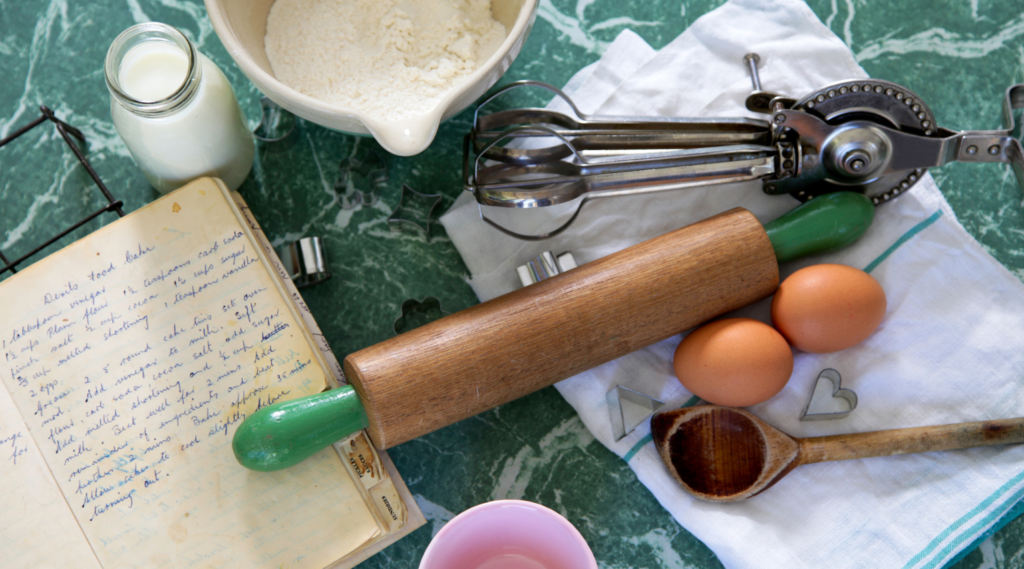Retro Baking From 1955
go.ncsu.edu/readext?767865
en Español / em Português
El inglés es el idioma de control de esta página. En la medida en que haya algún conflicto entre la traducción al inglés y la traducción, el inglés prevalece.
Al hacer clic en el enlace de traducción se activa un servicio de traducción gratuito para convertir la página al español. Al igual que con cualquier traducción por Internet, la conversión no es sensible al contexto y puede que no traduzca el texto en su significado original. NC State Extension no garantiza la exactitud del texto traducido. Por favor, tenga en cuenta que algunas aplicaciones y/o servicios pueden no funcionar como se espera cuando se traducen.
Português
Inglês é o idioma de controle desta página. Na medida que haja algum conflito entre o texto original em Inglês e a tradução, o Inglês prevalece.
Ao clicar no link de tradução, um serviço gratuito de tradução será ativado para converter a página para o Português. Como em qualquer tradução pela internet, a conversão não é sensivel ao contexto e pode não ocorrer a tradução para o significado orginal. O serviço de Extensão da Carolina do Norte (NC State Extension) não garante a exatidão do texto traduzido. Por favor, observe que algumas funções ou serviços podem não funcionar como esperado após a tradução.
English
English is the controlling language of this page. To the extent there is any conflict between the English text and the translation, English controls.
Clicking on the translation link activates a free translation service to convert the page to Spanish. As with any Internet translation, the conversion is not context-sensitive and may not translate the text to its original meaning. NC State Extension does not guarantee the accuracy of the translated text. Please note that some applications and/or services may not function as expected when translated.
Collapse ▲ Let’s take a trip back in time and look at what was being whipped up in the kitchen and learn a few interesting facts about sponge cakes.
Let’s take a trip back in time and look at what was being whipped up in the kitchen and learn a few interesting facts about sponge cakes.
- Eggs are the main ingredient in sponge cake. Use good quality, medium sized eggs. If the recipe calls for eggs by measure you will find that about 8 egg whites make 1 cup or about 5 whole eggs make 1 cup.
- Cake flour (such as Swans Down) or all purpose flour can be used in sponge cake. Most cakes will be more tender if made with cake flour which is a soft wheat flour.
- Lemon juice adds flavor to the cake. Because it is an acid, it also helps keep the cake from shrinking. Some cake recipes call for cream of tartar, also an acid. When making an angel food cake the acid keeps the cake from shrinking and makes it look whiter.
- Beat the eggs for sponge cake with an electric mixer, a rotary beater, or a wire whip. It is generally believed that a rotary beater or electric mixer produces a finer cake, whereas beating the whites with a wire whip makes a higher cake.
- Beat the egg whites until they are fine, glossy, and just stiff enough to hold a peak. Beat the egg yolks until they are thick and lemon colored. Fold the ingredients together with care.
- Be sure to measure all ingredients accurately. Be sure to sift the flour before measuring.
- Bake a sponge cake in an un-greased pan. Cool in the pan upside down. A sponge cake taken from a pan while hot may settle.
Sponge Cake (from 1955)
Ingredients
- 1 tablespoon lemon juice
- 1 teaspoon lemon rind
- 2 tablespoons water
- 1/2 teaspoon salt
- 1 cup sugar
- 6 eggs, separated
- 1 cup flour
Directions:
- Preheat oven to 350 degrees
- Add lemon juice, lemon rind, water and salt to 1/2 cup sugar. Blend well.
- Add upbeaten egg yolks and beat until very thick, at least 5 minutes.
- Sift 1/4 of the flour over this mixture, fold with a spatula using 8 to 10 strokes (all of flour does not need to disappear each time.) Repeat until all the flour is added and the mixture completely blended.
- Beat the egg whites until foamy. Add the remaining half of the sugar by tablespoons, beating after each addition. Continue to beat until stiff peaks are formed.
- Spread the egg yolk-flour mixture over the egg whites and gently fold together until well blended. Remember that folding gently is a secret of success.
- Pour batter into a 10-inch tube pan. Cut gently through batter to remove large air bubbles.
- Bake at 350 degrees for about 45 minutes. For oblong cake bake in 13″x9″ for 30 minutes. The cake is done when it shrinks slightly and springs back when touched.
- Cool cake in the pan, upside down, for 1 to 2 hours. Then loosen side and center tube with knife and gently pull out cake.





